

EP3813553 TITANIUM FREE OPACIFYING COMPOSITIONS. US6207207 Coated confectionery having a crispy starch based center and method of preparation. Les chocolats noir et blanc sans colorant. COLORANTS 2020 compressed compressed. Natural Colors and Caramel Colors - DDW, The Color House. SERPROQUIM FOOD. Natural Food Colours Association. Rice starches, clean label, gluten-free texturizers. Improved product stability in infant meals.

Vegetable and fruit based infant meals and jars with baby-food-grade rice starch show improved product stability in terms of viscosity, syneresis control and shelf-life. In addition, the small granule size creates a creamy texture without affecting the end product’s taste or colour. Clean label alternatives for confectionery.
As a clean label whitening agent in confectionery coatings (e.g. chewing gum, hard candy, chocolate lentils), regular rice starch provides a natural alternative to other artificial colouring agents. Customized pigments: Natural claims in food colors drive consumers to bright and bold hues. 24 May 2021 --- The natural colors space continues to gather speed in its shift toward close-to-nature ingredients, which are phasing out artificial dyes.
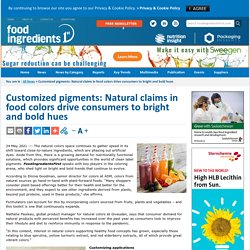
Aside from this, there is a growing demand for nutritionally functional solutions, which provides significant opportunities in the world of clean label pigments. FoodIngredientsFirst speaks with key players in the coloring arena, who shed light on bright and bold trends that continue to evolve. According to Emina Goodman, senior director for colors at ADM, colors from natural sources go hand-in-hand with plant-forward foods. “Many shoppers consider plant-based offerings better for their health and better for the environment, and they expect to see other ingredients derived from plants, beyond just proteins, used in these products,” she affirms. Confectionery News - Chocolate industry, Candy industry. Two New Solutions to Replace Titanium Dioxide - Sensient Food Colors : Sensient Food Colors. Uncertainty about the Acceptability of Titanium Dioxide Since Dunkin’ Brands removed titanium dioxide from their powdered donuts after being pressured by the activist group ‘As You Sow’, we have noticed a significant increase in the number of requests for titanium-free alternatives across many applications.
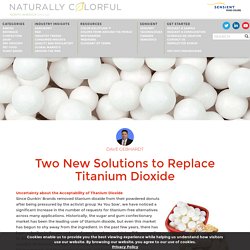
Historically, the sugar and gum confectionary market has been the leading user of titanium dioxide, but even this market has begun to shy away from the ingredient. In the past few years, there has been a decline in the percentage of new launches containing TiO2, according to data from Mintel. In Europe, we have witnessed increased regulatory scrutiny of titanium dioxide. For example, the French Agency for Food, Environmental and Occupational Health and Safety (ANSES) submitted a proposal to European Chemicals Agency (ECHA) requesting the classification of TiO2 be changed to a 1A or B carcinogen. Nos solutions de pâtisserie et chocolat sans dioxyde de titane - Puratos. Il n’y aura plus de dioxyde de titane E171 dans les M&M’s. We and our partners do the following data processing based on your consent and/or our legitimate interest: Store and/or access information on a device; Create a personalised ads profile; Select personalised ads; Measure ad performance; Select personalised content; Select basic ads; Develop and improve products; Create a personalised content profile; Measure content performance; Apply market research to generate audience insights; Ensure security, prevent fraud, and debug; Technically deliver ads or content.
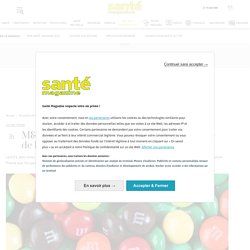
These technologies may process personal data such as IP address and browsing data to offer following functionalities: Actively scan device characteristics for identification; Use precise geolocation data; Match and combine offline data sources; Link different devices; Receive and use automatically-sent device characteristics for identification. Nous recourons aussi à des services d’affichage publicitaire qui n’utilisent pas de cookies. E171 - Bixyde de Titane - Colorants Blanc - ADDITIF ALIMENTAIRE - Webadditifs. Coloriages alimentaires : la chimie des colorants naturels (...) Colorants alimentaires. Colorants et pigments : Dossier complet. Natural Colorants: Food Colorants From Natural Sources - PubMed. The color of food is often associated with the flavor, safety, and nutritional value of the product.
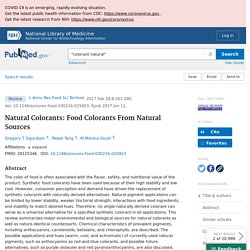
Synthetic food colorants have been used because of their high stability and low cost. However, consumer perception and demand have driven the replacement of synthetic colorants with naturally derived alternatives. Natural pigment applications can be limited by lower stability, weaker tinctorial strength, interactions with food ingredients, and inability to match desired hues. Therefore, no single naturally derived colorant can serve as a universal alternative for a specified synthetic colorant in all applications. This review summarizes major environmental and biological sources for natural colorants as well as nature-identical counterparts. A Colored Avocado Seed Extract as a Potential Natural Colorant - PubMed. There is an increasing consumer demand for and scientific interest in new natural colorants.
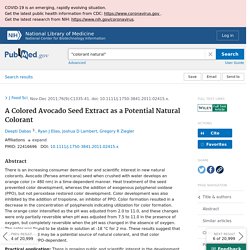
Avocado (Persea americana) seed when crushed with water develops an orange color (= 480 nm) in a time-dependent manner. Heat treatment of the seed prevented color development, whereas the addition of exogenous polyphenol oxidase (PPO), but not peroxidase restored color development. Swap titanium dioxide in confectionery with rice starch: Beneo. Rudy Wouters, vice president of Beneo’s Technology Center told ConfectioneryNews that artificial color titanium dioxide had been flagged as a possible cancer risk and moving to a natural alternative would meet strong consumer demand for clean label products.
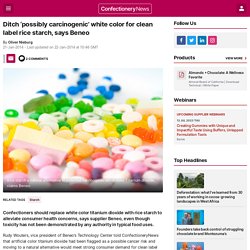
“In confectionery there are ingredients coming under pressure and titanium dioxide is one of them,” he said. Titanium dioxide: exposure, risk, perception Titanium dioxide is used as a whitener in many confectionery products such as chewing gum and sugar coated candies but is most commonly used in sunscreens. The additive has been classified by the International Agency for Research on Cancer (IARC) as, ''possibly carcinogenic to humans'', although this was in relation to respiratory exposure among workers manufacturing the chemical.
In the food supply, no conclusive link has been established between titanium dioxide and health risks, though one study has suggested a link to Crohn’s disease. Campbell Soup remplace le dioxyde de titane / Brevets. 18/04/2018 Les confiseurs en quête d’alternative au dioxyde de titane. EXBERRY® Coloring Foods’ plant-based potential at ProSweets Cologne. Titanium-Free Food Color Alternatives Market forecast 2019 – 2029 available in the latest report. The growing trend for natural and organic food color is resulting in shift from titanium dioxide, a synthetic ingredient, towards titanium-free food color alternatives and extracting food colors from alternative natural sources.
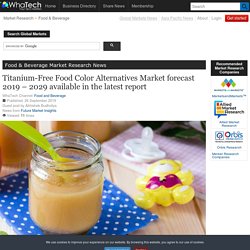
Natural food color sources include astaxanthin, beta carotene, annatto, and anthocyan n. Other ingredients that can be used as an alternative to titanium are silica dioxide and calcium phosphate in food colors. Increasing consumer preference for food products free from synthetic colors is resulting in the growing demand for titanium-free food color alternatives. Titanium Free Food Color Alternatives Market Size, Historical Growth, Analysis, Opportunities and Forecast To 2029 - PharmiWeb.com. VALLEY COTTAGE, N.Y. – The growing trend for natural and organic food color is resulting in shift from titanium dioxide, a synthetic ingredient, towards titanium-free food color alternatives and extracting food colors from alternative natural sources.

Natural food color sources include astaxanthin, beta carotene, annatto, and anthocyanin. Other ingredients that can be used as an alternative to titanium are silica dioxide and calcium phosphate in food colors. Increasing consumer preference for food products free from synthetic colors is resulting in the growing demand for titanium-free food color alternatives. Reformulation of food products by food companies is rising to replace synthetic colors with natural colors. Replacing Titanium Dioxide in Mid to High Water Activity Applications - Sensient Food Colors : Sensient Food Colors. November 2017 Demand for Titanium Dioxide Alternatives Spurs Innovation Last year, we launched two new solutions under our Avalanche™ brand addressing the need for more label-friendly, white alternatives to titanium dioxide (TiO2) in low and mid water activity applications, including panned confections, coating systems, frosted cereals, and more.

These colour systems certainly were a leap forward in the existing natural colour technology landscape, but didn’t quite close the gap for titanium dioxide alternatives. Comment Mentos et Chupa Chups ont réussi à se passer du dioxyde de titane - L'Usine Agro. Swap titanium dioxide in confectionery with rice starch: Beneo. Swap titanium dioxide in confectionery with rice starch: Beneo.